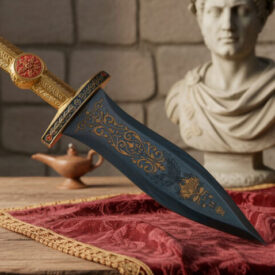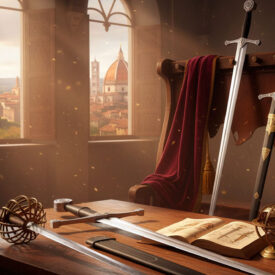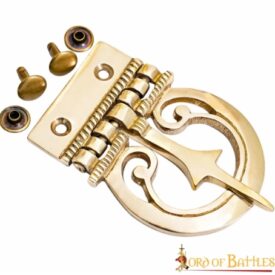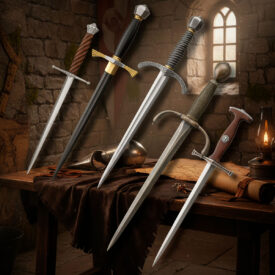What do you see in the shadows of a Venetian alley, invisible and lethal, that has more power than a blade that seeks not to cut but to penetrate to the heart of history? The Venetian stiletto is one of those pieces that combine precision, mystery, and an artisanal tradition that spans centuries. In this article, you will discover its origin, its technical evolution, its Renaissance and modern variants, and how to recognize faithful replicas without losing the narrative thread that links art, war, and urbanity.
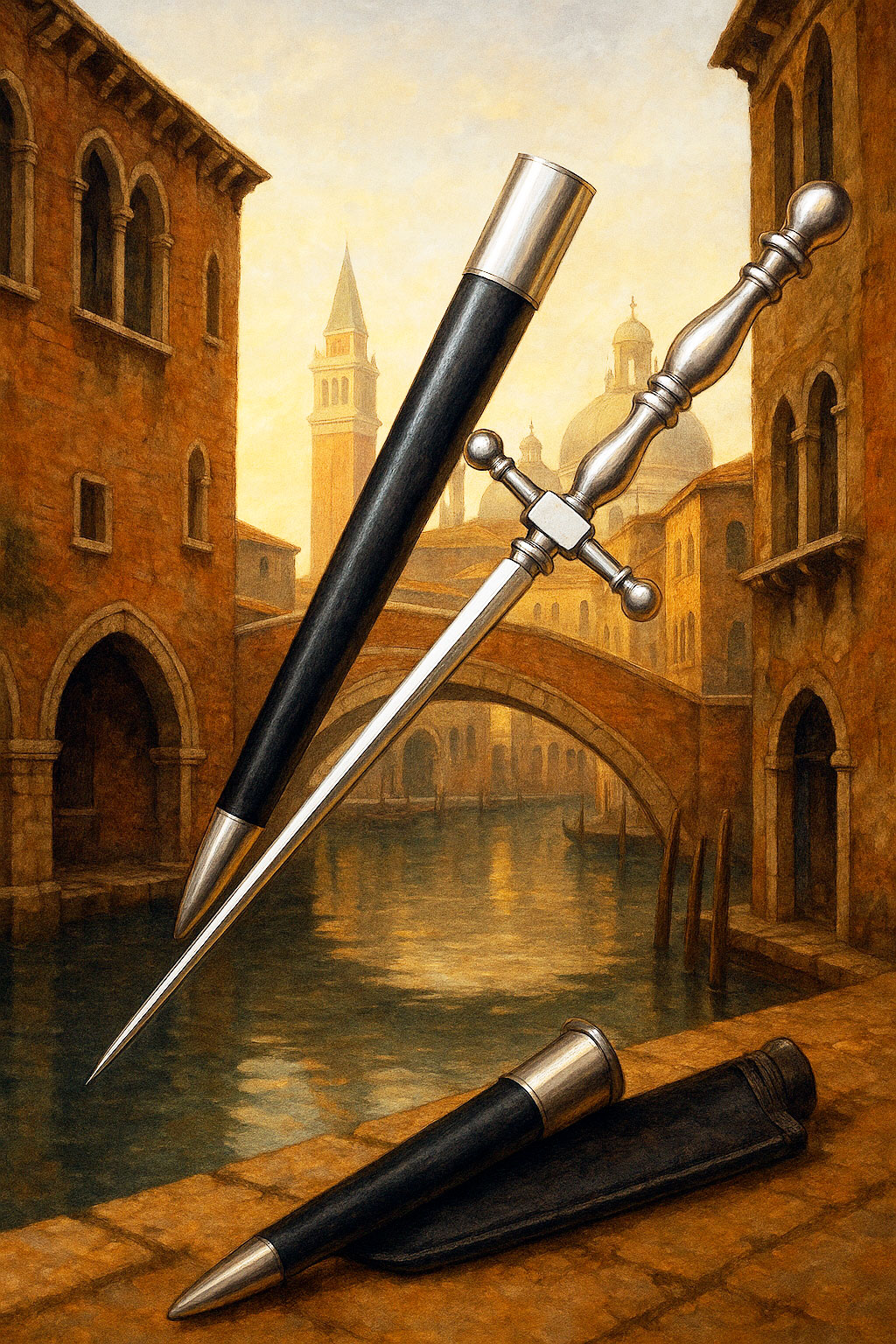
The Stiletto in Two Sentences: Puncture Weapon and Symbol of an Era
The stiletto is, first and foremost, a dagger designed for thrusting. Its long, rigid blade favors penetration over cutting. In European history, and especially in Italian cities like Venice, it became both a military tool and a social and artistic distinguishing mark.
Throughout the following sections, you will trace its origins from its earliest roots to the transformations that led to automatic knives and the refined Cinquedea of the Renaissance. You will also find original visual pieces distributed throughout the text to illustrate each stage.
Evolution of the Stiletto and Related Daggers
| Era | Event |
|---|---|
| Stone Age | Flint points attached to wood or bone handles; early daggers as rudimentary tools and weapons. |
| Third millennium BC (Bronze Age) | Decorated metal daggers appear, used as weapons and status symbols. |
| Iron Age | More versatile and efficient daggers; specialized forms emerge such as the Sax (short, single-edged dagger-sword). |
| 12th Century (Middle Ages) | The “dagger of mercy” (coup de grâce) is born, a precursor to the stiletto, used by knights to finish off wounded opponents by penetrating vulnerable points of armor. |
| 14th Century (Middle Ages) | Spread of the Basilardo in Europe (I-shaped hilt) as a weapon and status symbol; evidence of cutlery production in Maniago (Italy). |
| 15th Century (Late Middle Ages / Early Renaissance) |
|
| 16th – 17th Century (Renaissance) |
|
| Early 17th Century | The “Genoese knife” emerged in Genoa; transition towards a more civil and generalized use knife, with handle-less grips and occasional additional hidden blade. |
| Late 18th – Early 19th Century | Spread of folding knives in Italy adopting stiletto geometry; regional development of designs such as the “Piemontese” and the “Raven” of Ravenna (dueling variants with long blades). |
| 19th – 20th Centuries | Appearance of specialized daggers for modern military purposes, e.g., commando and paratrooper daggers. |
| 20th Century (Modernity) |
|
| Contemporary Summary | The Italian stiletto endures as a legendary weapon from the past and a symbol of Italy’s centuries-old cutlery culture, valued today as an art object and collector’s item. |
Origin, Name, and Purpose: Why the Stiletto Was Born
The name comes from the Italian stiletto, derived from the Latin stilus, meaning stake or punch. That name summarizes its function: an elongated and sharp piece designed to pierce. It arose as a technical response to the increasing protection of armor. When cutting blows were no longer effective, a precise thrust became essential.
It was not an isolated invention, but a continuous adaptation: from the “dagger of mercy” of the 12th century to the puncture daggers of the 15th, the evolution reflected the reality of the battlefield and urban life.
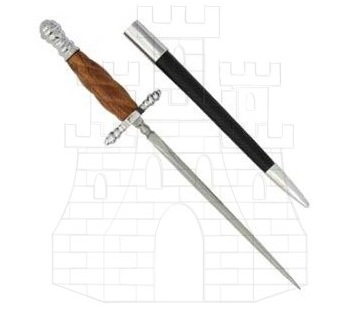
Design and Geometry: What a Venetian Stiletto Looks Like
If you mentally unsheathe a stiletto, you will see a very rigid blade, with a core and a narrow tip. Some have a triangular section, others are almost rhomboidal or have four bevels. The rigidity in the central section is what allows the tip not to bend and to pass through layers of metallic protection.
Common technical characteristics:
- Blade length: typically between 22 and 35 cm, although there are shorter and longer variants depending on the use.
- Section: triangular or with a central rib to increase resistance.
- Material: carbon steel (for example, 1055 in modern replicas) to balance hardness and toughness.
- Handle: wood, horn, or noble materials with a metal pommel; often simple, designed for a firm grip.
- Sheath: wood covered with leather, designed to preserve the blade and allow concealed carry.
Comparative Table: Venetian Stiletto vs. Other Puncture Daggers
| Aspect | Venetian Stiletto | Cinquedea | Dagger of Mercy |
|---|---|---|---|
| Main Function | Punctual penetration | Hybrid thrust/slash version, status symbol | Finishing in battle |
| Blade Section | Triangular/rigid | Broad at base, flat | Thin and pointed |
| Typical Length | 22-35 cm | 25-45 cm | 20-30 cm |
| Usage | Military and civilian (concealment) | Cuts and thrusts, display | Battlefield |
Venice, Society, and the Stiletto: More Than a Weapon
Venice, a crossroads of trade routes and a scene of political intrigues, was fertile ground for the stiletto. In the city-state, the dagger served not only for combat but was part of a social language. The Cinquedea — although not strictly a stiletto — illustrates how Italian daggers were transformed into artistic and prestigious objects.
Carry a Cinquedea and you speak before you open your mouth: the engraving, the goldsmithing of the guard, and the blade turn the weapon into a medallion of identity. The stiletto, due to its discretion, was more utilitarian for the city and more feared in the alleys where a silent thrust made all the difference.
Stilettos in Civilian Life and Duels
During the Renaissance, the stiletto became common among the bourgeoisie. You could carry it concealed and defend your honor in a duel or a brawl. For duels, more developed guards and quillons were added, transforming some daggers into tactical complements to the sword.
At the same time, soldiers used it for everyday tasks: cleaning firearms, preparing food, or as a work tool if needed. Its versatility made it indispensable outside the battlefield.
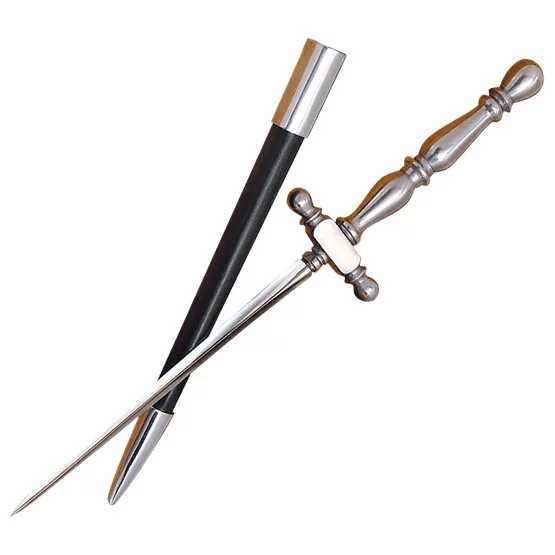
Mechanical Evolution: From Stiletto to Automatic Knife
The geometry of the stiletto influenced many civilian cutlery designs. In Genoa, the “Genoese knife” appeared, and later, regions like Maniago perfected the cutlery trade.
In the 20th century, the Italian industry led the production of automatic knives. Mechanisms like the picklock or leverletto resulted in switchblades that retained the stiletto’s silhouette with shorter blades and sophisticated mechanisms.
The Stiletto in Popular Culture
Films and legends have linked the stiletto with scenes of mafia and conspiracy. This appearance in popular culture solidified its image as both a dangerous and elegant object, and often fueled its fame in the collective imagination outside of Italy.
How to Recognize a Faithful Replica: Materials, Forging, and Finishes
If you are attracted to history and seek faithful replicas, it is useful to know the details that separate a museum piece from a decorative reproduction. These are the essential criteria to evaluate:
- Steel: 1055 is common in functional replicas due to its balance of hardness and ductility. An exhibition piece may use softer steels.
- Blade section: the triangulation or central rib should be appreciable at first glance; its absence indicates a more ornamental reproduction.
- Handle: noble materials (stabilized wood, horn) and assembly with a metal pommel indicate a carefully crafted replica.
- Sheath: lined wood and tight fit are characteristics of pieces designed to preserve the blade.
- Forging and tempering: proper tempering and a clean transition between the section and the tip are signs of correct forging.
Quick Checklist for Collectors
- Presence of a rib or triangular section.
- Coolness and firmness of the tip to the touch (without bends).
- Careful finishes on the handle and pommel.
- Wooden sheath with textile or leather lining to prevent corrosion.
Essential Maintenance Without Technicalities
A functional replica requires cleaning and light oil to prevent corrosion. Keep the edge free of residue and store the blade in a dry sheath. Avoid humid environments and periodically check the rivets or fastenings of the handle.
If the piece has engravings or decorations, clean them with soft brushes and neutral products; aggressive products damage the patina and the base metal. For wood or horn handles, use specific oils in very small quantities and sparingly.
Legal and Liability Aspects
The stiletto, due to its design, may be restricted in many jurisdictions. Before carrying, publicly displaying, or transferring a replica, inform yourself about local laws regulating the carrying of bladed weapons or automatic knives. The owner’s responsibility is to care for the object and comply with current regulations.
Technical Comparison: Sizes, Weights, and Recommended Uses
To better organize the variants, I have prepared a table that will help you understand what to expect according to the length and type of stiletto.
| Type | Blade Length | Approximate Weight | Historical Use |
|---|---|---|---|
| Classic Venetian Stiletto | 22-30 cm | 150-300 g | Military thrust and civilian defense |
| Cinquedea | 25-45 cm | 300-700 g | Display, slash, and thrust |
| Automatic Knife (stiletto-inspired) | 8-12 cm | 80-180 g | Urban portability |
Stories and Anecdotes: Moments Where the Stiletto Changed a Destiny
Italian chronicles are filled with tales where a small dagger decided a duel or a conspiracy. In densely populated city-states, discretion was a weapon, and a silent thrust, a sentence. This same quality eventually turned it into a romantic and dangerous symbol in literature and cinema.
For the artisan, the stiletto was an opportunity to show skill: a perfectly aligned tip, a well-turned pommel, a sheath that embraced the blade. Every detail told a story, and every piece was a narrative in metal.
The Contemporary Legacy: Collecting, Replica, and Experimental Archaeology
Today, interest in the stiletto lies at the crossroads of collecting, historical reenactment, and experimental archaeology. Collectors seek pieces with history; reenactors prefer functional replicas for combat trials; museums value documentation and provenance. You, as a hobbyist or collector, can learn to read a piece by its forging and patina.
The demand for well-made replicas has also encouraged modern blacksmiths to revive traditional techniques and present stilettos faithful to the original design, with materials and tempering that imitate ancient pieces as closely as possible.
Functional Venetian stiletto with sheath. The blade has a triangular shape and is made of 1055 high carbon steel. The handle is made of wood with a metal pommel. The stiletto includes a leather-covered wooden sheath.
For those seeking to connect piece and history, the key is to understand that each stiletto speaks of its time: of war, of fashion, and of necessity. Its elegance is born of function.
Final Words Inviting a Closer Look
The Venetian stiletto encapsulates a paradox: small in appearance, immense in meaning. It reminds us that military technology and craftsmanship walk hand in hand, and that an object can simultaneously be a tool, a weapon, and a jewel. If your interest leads you to study or collect, do so with respect for history and for the rules that protect everyone.
VIEW MORE HISTORICAL DAGGERS | VIEW OTHER PERIOD DAGGERS | VIEW HUNTING KNIVES
